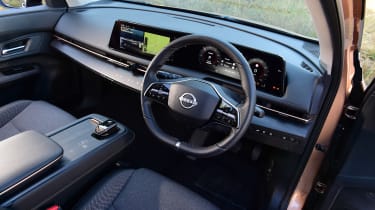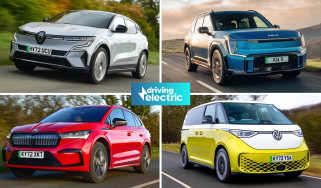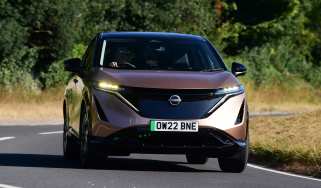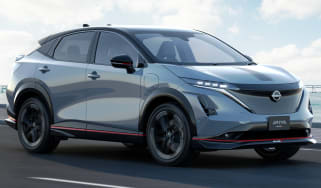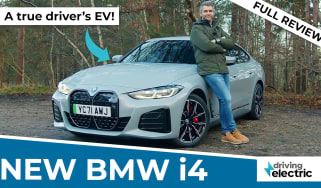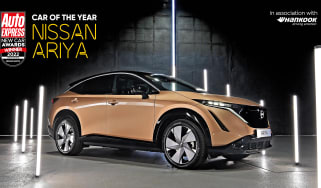Nissan Ariya review
Comfortable, refined and striking, Nissan’s follow-up to the pioneering Leaf is a strong contender in the electric family-car class
Pros
- Excellent visibility
- Very spacious and refined
- Looks great inside and out
Cons
- Premium price
- Average boot space
- Charging could be faster
|
Model |
Range |
Wallbox charge time |
Rapid charge time |
|
63kWh FWD |
250 miles |
10hrs (0-100%, 7.4kW) |
31mins (10-80%, 130kW) |
|
87kWh FWD |
329 miles |
14hrs (0-100%, 7.4kW) |
35mins (10-80%, 130kW) |
|
87kWh 4WD |
309-319 miles |
14hrs (0-100%, 7.4kW) |
35mins (10-80%, 130kW) |
Nissan Ariya verdict
If you’re used to the ‘no-frills’ nature of the Nissan Leaf, you’ll certainly be shocked by the newer Ariya’s fashionable SUV looks and contemporary cabin. On the inside, the Nissan Ariya feels incredibly spacious and boasts material quality that can even rival premium offerings in the electric family SUV class. For such a large car, the Ariya’s boot is disappointingly small, though, and it is rather expensive – the new entry-level Engage trim does a bit to offset this problem. Regardless, light steering and a comfortable ride makes it a doddle to drive around town and an ideal choice for a zero-emissions school run.
Range details, specs and alternatives
In 2010, the Nissan Leaf came to market and thrust electric cars into the mainstream. Since then, over half a million examples of the zero-emissions hatchback have been sold, but despite the Leaf’s success, it took Nissan over a decade to launch a follow up: the all-new Ariya.
The Ariya is an electric family SUV, similar in size to Nissan’s X-Trail, and based on the same EV-specific platform as the Renault Megane E-Tech hatchback. It’s the same technology that’ll eventually underpin the crossover SUV set to replace the Nissan Leaf, as well as the electric successor to the Nissan Micra supermini. Both are due to arrive by 2025.
There is a sea of acclaimed electric family cars the Ariya must fend off, including the Hyundai Ioniq 5, Tesla Model Y, Volkswagen ID.4, Skoda Enyaq, Kia EV6 and Toyota bZ4X. There’s also the upcoming Ford Explorer, as well as more premium options like the BMW iX1 and Audi Q4 e-tron.
Nissan has revamped the Ariya lineup for 2023, although the choice of two battery sizes and front or e-4ORCE all-wheel drive remains the same. Entry-level models get a smaller 63kWh battery which, according to Nissan, will allow the Ariya to cover 250 miles on a charge. Upgrading to the larger 87kWh battery increases the car’s range to 329 miles if you stick with front-wheel drive, while dual-motor e-4ORCE models – available in 302bhp and 388bhp forms – will go 319 and 309 miles respectively before the battery runs flat.
New for 2023, the base Engage trim starts from around £40,000. Despite its low price, it still comes loaded with all the necessary creature comforts like LED headlights, dual 12.3-inch screens with Apple CarPlay and Android Auto connectivity, plus an array of safety aids including blind spot monitoring and a reversing camera.
Stepping up to the Advance trim nets you things like a powered bootlid, synthetic leather upholstery and a 360-degree camera setup, while Evolve cars get a panoramic sunroof, Bose sound system and heated and cooled front seats.
Also new for 2023 is the Evolve+ trim which is exclusively available with the aforementioned 388bhp e-4ORCE powertrain. This gets huge 20-inch wheels as standard, as well as blue Nappa leather upholstery; 0-62mph takes just 5.1 seconds, making the Ariya Evolve+ a rival for other hot electric SUVs like the Skoda Enyaq vRS.
Click here to see why you can trust DrivingElectric reviews, or for a more detailed look at the Nissan Ariya, read on for the rest of our in-depth review…

